The Portrait of Verdi’s aria O DON FATALE
Read Interesting facts and hear great YouTube Videos about the famous Aria “O DON FATALE”.
If you want to hear more about the opera DON CARLO, click on the link to the opera portrait
The aria – synopsis and background
Synopsis: Don Carlo loves Elizabeth, the young wife of his father, King Philip II of Spain. Princess Eboli, a lady-in-waiting and friend of Elizabeth, has fallen in love with the Infante Don Carlo and asks herself if he will reciprocate her feelings. She meets Don Carlos in the Queen’s garden. He has received a letter for a rendez-vous and awaits the Queen. In fact, the letter is from Eboli, who appears in the Queen’s cloak. Carlos swears his love to the supposed Queen. Horrified, Eboli must realise that it was not mean for her when Carlos recognises her. Blinded by jealousy she wants to take revenge. She secretly gives the king the queen’s jewelry box. Blinded by anger and jealousy he calls for the Queen. Horrified she has to watch how the king puts the box on the table and breaks it open. At the top he finds the portrait of the Infante. Elizabeth claims to be pure and when he accuses her of adultery, Elizabeth faints and Philip realises that he has gone too far. Rodrigo and Eboli rush in and realise the situation. Eboli repentantly confesses to the queen that it was she who had betrayed her and handed the casket over to the king. And she also confesses that she had seduced the king. The queen gives her a choice between monastery and exile. Eboli repents and as a last act she decides to save Don Carlo who is in the dungeon awaiting his execution.
Verdi has written a wonderful role-portrait for the Eboli. Her role is very diverse and none of the other characters in this opera shows so many facets and development. In her three great performances she first sings the courtly lady (the Moorish song) with coloraturas, then she becomes the dramatic intriguer (A mezzanotte) and in this aria she becomes the repentant and finally the light figure. In other words, the role of Eboli calls for a great voice.
The musical highlight of the Eboli is undoubtedly this aria. It is introduced with a dramatic ‘Ah’ with a high G, followed by an almost physically palpable collapse, which Verdi leads to the low E flat in a dramatic sequence of three bars, accompanied by the sharp accents of the winds. It is Eboli’s painful realisation that she will never be able to see Elisabeth again.
The short sentences at the beginning of the aria show the turmoil of the Eboli. They are accompanied by the orchestra with a fateful figure, which gives the whole thing a tremendous dramatic effect.
The first part ends with a dramatic “ti maledico” (I curse you).
In the variation of the first part, the aria changes into a “piu mosso”. Verdi increases the tempo and accelerates the orchestra accents, driving the singer into a hysterical “ti maledico” with a high C, which is a considerable challenge for a mezzo-soprano.
The second part sets a maximal contrasts to the beginning. The mood changes abruptly and changes into a tender atmosphere. In gentle legato she regrets her deeds.
The mood, initially nostalgic, changes into deep despair and leads to the decision to enter the monastery, which is introduced with a painful high D flat.
The third part is dedicated to Don Carlo, whose execution is imminent. She is ready to sacrifice herself to save the Infante. The atmosphere becomes frantic…
…and ends with an ecstatic “lo salverò”.
The Aria – the text of O DON FATALE
O don fatale! O don crudel
che in suo furor mi fece il ciel!
Tu che ci fai sì vane, altere,
ti maledico… Ti maledico,o mia beltà!
Versar, versar sol posso il pianto,
speme non ho, soffrir dovrò!
Il mio delitto è orribil tanto
che cancellar mai nol potrò!
Ti maledico! Ti maledico, o mia beltà!
O mia Regina, io t’immolai
al folle error di questo cor.
Solo in un chiostro al mondo ormai
dovrò celar il mio dolor!
Ohimè! Ohimè! O mia Regina…
O ciel! E Carlo! a morte domani…
Gran Dio! A morte andar vedrò!
Ah, un dì mi resta!
La speme mi arride, ah…!
Sia benedetto il ciel! Lo salverò!
Un dì mi resta!
Ah, sia benedetto il ciel! Ah! lo salverò!
Vocal Fach «Dramatic mezzosoprano»
The role of Eboli is written for a dramatic mezzosoprano. The dramatic mezzosoprano must have a strong, voluminous voice. The demand for vocal creativity is high, which is why these roles are usually entrusted to vocally mature and experienced singers. The role requires a high resilience and endurance of the singer.
Famous interpretations of O DON FATALE
Maybe this aria has been sung more lyrical, but none of them managed to create the timbres to draw the soul state of the Eboli.
O don fatale – Callas
The counterpart to Callas was Verretts interpretation. Her voice is rounder and fuller compared to Callas’ accentuated interpretation.
O don fatale – Verrett
Next we will hear the Eboli of Elina Garanca. In the words of Mark Pullinger: “Elīna Garanča, as the glamorous Eboli, brought the house down, pulling out all the stops in the Moorish veil song, as one would expect from someone with her bel canto background. It surprised how much her mezzo-soprano had grown, delivering a breathtaking “O don fatal”.
O don fatale – Garanca
Nilsson’s Eboli captivates with the drama of despair in the first part. The deeper lyrical passages of the middle section are somewhat less captivating, but the final section gleams like a shining sword.
O don fatale – Nilsson
Stignani was the preferred Eboli of the 30s and 40s. Her vocal artistry was grandiose and the Eboli was one of her favourite roles.
O don fatale – Stignani
Next, we hear a brilliant recording of Christa Ludwig. She confessed that this dramatic part took her to the limits, especially the passages with high notes. We learn an exemplary story from Kesting’s book: “How this can end was shown in August 1975 in a Salzburg performance under Karajan when she failed at the end of the Eboli Aria. She herself said that she had “not succeeded in striking the last note of my great aria, but the fact that she left after the audience booed her, and that she did not sing at the second performance, shows the enormous nervous strain of the best.
O don fatale – Ludwig
Peter Lutz, opera-inside, the online opera guide to the aria “O DON FATALE” from the opera Don Carlo from Giuseppe Verdi.

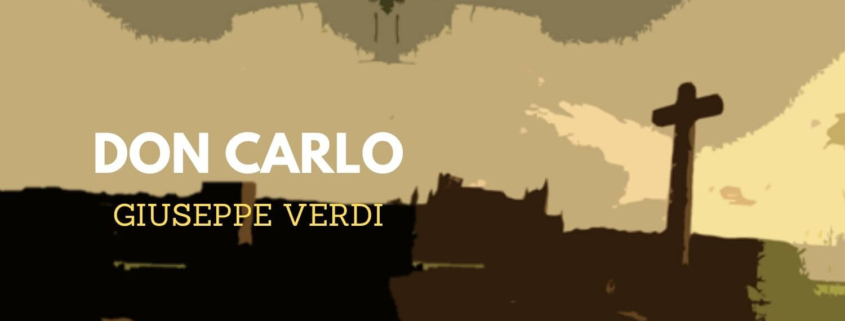
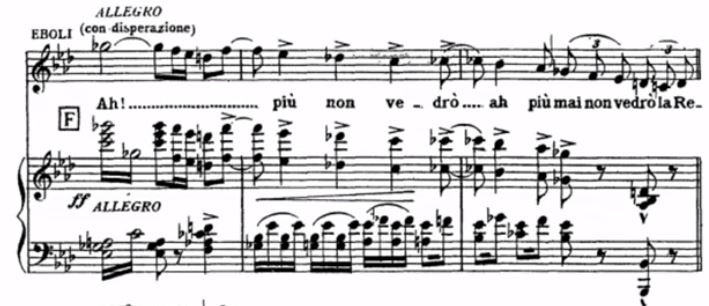
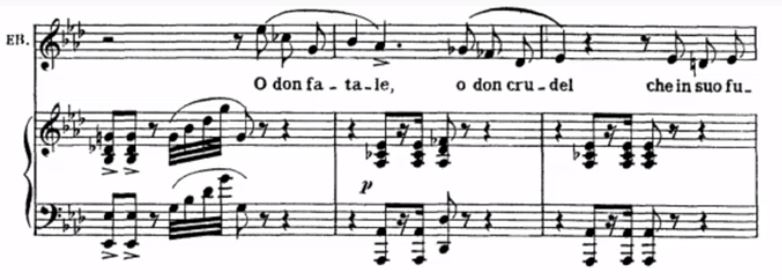
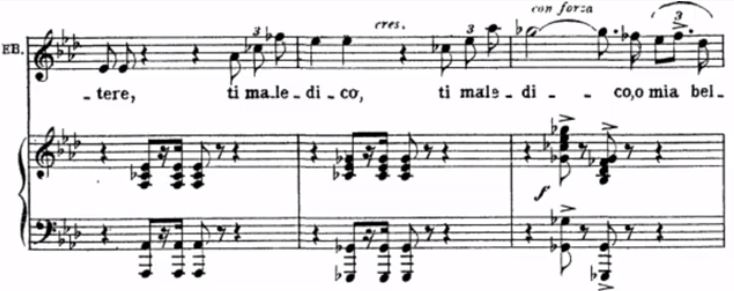
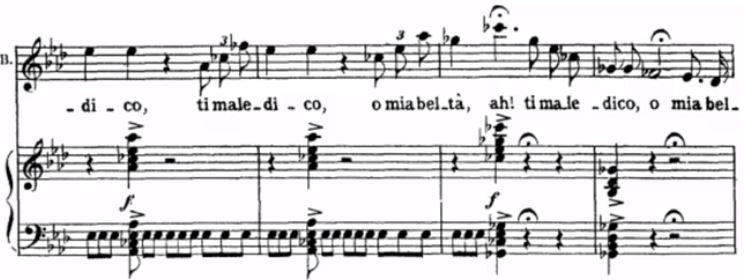
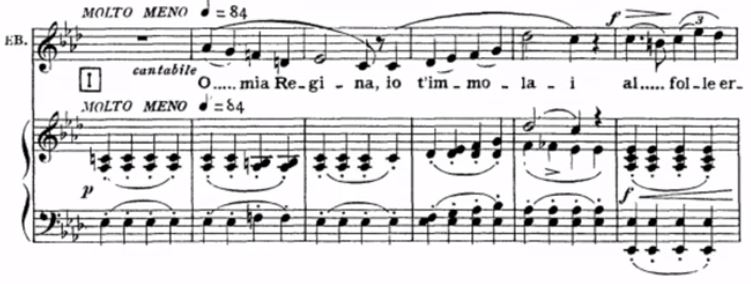
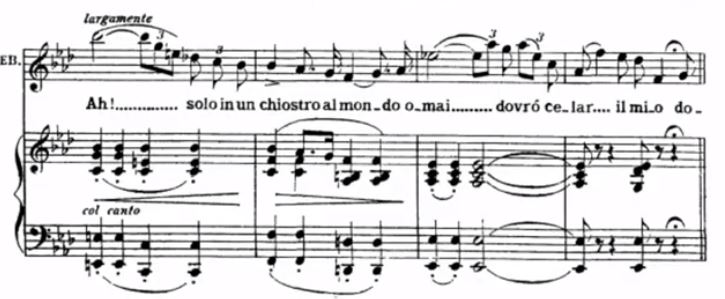

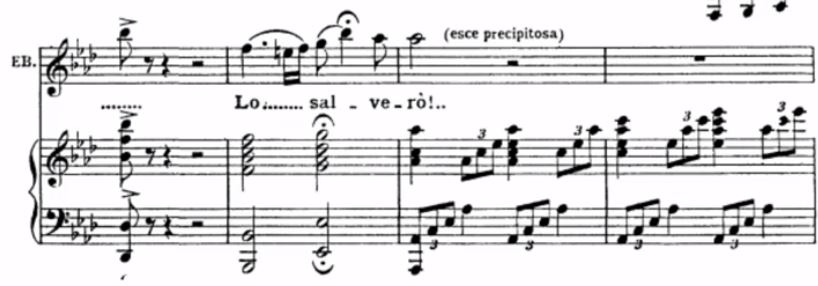


Please remember that G-flat is NOT a G and C-flat is NOT a C!